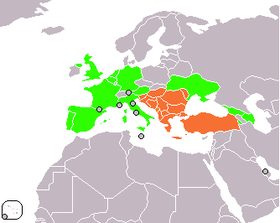Southeast European Cooperative Initiative

The Southeast European Cooperative Initiative (SECI) was launched in December 1996 to help provide regional peace and stability among the countries of southeastern Europe through cooperative activities, and to help the countries integrate into the rest of Europe. The organization, founded by Erhard Busek and Richard Schifter, has provided regional stability, and has found support in international organizations and countries.
In 2009, the SECI created a Regional Cooperation Council (RCC), owned and run by countries mainly in southeast Europe, aimed at strengthening peace, democracy and the economy.
The SECI headquarters are located within the Hofburg Palace in Vienna.
Membership
- Member states:
- Observer European states:
- Observer states outside Europe:
- Observer International Organizations:
- International Organization for Migration (IOM)
- European Institute for Law Enforcement Cooperation (EULEC)
- International Centre for Migration Policy Development (ICMPD)
- United Nations Mission to Kosovo (UNMIK)
History
Background of the SECI
The SECI was formed in 1996 under the guidance of Richard Schifter, at the time the Senior Director for Eastern Europe in the United States National Security Council. The group's mission was modeled after the Marshall Plan of 1947, which helped rebuild Europe after World War II. Since the war in Bosnia and Herzegovina was coming to a close, Schifter saw a need for greater stability in the region. His initial plan, called the Southeast European Cooperative Development Initiative, was intended to focus on regional cooperation of the countries in Southeast Europe (SEE), and not be considered a financial assistance plan. The idea was to allow SEE countries access to resources that would help them rebuild and stabilize, but not to provide money. Instead, outside organizations and countries like the United States would offer technical assistance and provide experts on relevant subjects. Schifter’s hunch was realized on 14 December 1995, when a cease-fire was announced and peace negotiations were signed in Dayton, Ohio under the Dayton Agreement.
Difficulties of formation
The next step was to get all the countries in the region together and agree to join a cooperation initiative, an extremely difficult task considering the ethnic tension that dominated the region. The SECI was originally composed of Albania, Bosnia and Herzegovina, Bulgaria, Macedonia, Greece, Hungary, Moldova, Romania, Turkey, Yugoslavia, Croatia and Slovenia. However those last three participants caused some growing pains for the initiative in its nascent stages. Yugoslavia’s invitation was revoked after the country cancelled local election results when a minority party won the popular vote, eventually being allowed in as Serbia and Montenegro and Slovenia and Croatia originally agreed to join but only as observer nations. The Slovenian concern was that they were a Central European country, not part of SEE, but once Hungary joined, they quickly followed suit. Croatia was more of a challenge in that not only did they not see themselves as a SEE country, but President Tudjman in an interview with Richard Schifter said that Croatia was a “Catholic, Mediterranean country” that wants nothing to do with the “Orthodox and the Muslims.” In 1999, President Tudjman was hospitalized, eventually dying, and shortly after, Croatia joined the SECI as a full-fledged member. Kosovo is another area of contention for the SEE countries. During the time of the formation of the SECI, in 1996, they were only recognized as a region and by 1999, they were governed by the United Nations Interim Administration Mission in Kosovo (UNMIK), under the UNSC Resolution 1244; in February 2008, the Assembly of Kosovo declared its independence from Serbia. Despite this, they are still only recognized as an independent state by 113 UN member states, with Russia and Serbia leading the opposition of the declaration and the European Union having no official position on the situation as well as the United Nations saying that Resolution 1244 will remain the legal framework in Kosovo. Kosovo has never been and currently is not considered a member state by the SECI either, only a permanent observer.
See also
- Stability Pact for South Eastern Europe (SP for SEE)
- South-East European Cooperation Process (SEECP)
- Central European Free Trade Agreement (CEFTA)
- Central European Initiative (CEI)
- Black Sea Economic Co-operation (BSEC)
- Regional Cooperation Council (RCC)
- Partnership for Peace Information Management System (PIMS) and South-Eastern Europe Defense Ministerial process (SEDM)